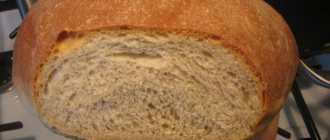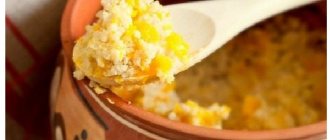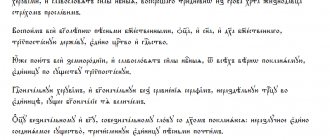For a long time, one of the Russian Orthodox traditions was the production of bread in monasteries. Surprisingly, the practice of making monastic bread survived even the Soviet Union and continues to this day. It should be understood that this product in its natural form is quite rare and has its own niche of buyers who strive to eat products made exclusively from plant products without the addition of margarine and eggs, as well as various chemical additives and preservatives. This article will look at how to make Lenten monastic sourdough bread yourself.
What is monastery bread?
At the moment, food production is switching to automatic labor at an accelerated pace. Indeed, in this way you can significantly save time and money, which are so important for entrepreneurs. However, in practice it has long been noticed that such changes lead to the fact that the quality of the product made in this way is significantly lower.
It is worth preparing for the fact that making yeast-free monastery bread yourself at home will be incredibly difficult and will require time and effort. The immediate recipe of the product requires adherence to ancient baking methods. But bread prepared in this way will not only be incredibly tasty, but also healthy.
Cooking features
As mentioned earlier, monastery bread without yeast requires adherence to ancient methods. First of all, you will need to prepare exclusively natural ingredients. Therefore, you should immediately set the yeast aside. They have never been used in the preparation of this type of bread, since it is believed that only lazy people can cook with yeast.
Therefore, you should prepare for the fact that you will first need to learn how to prepare sourdough for bread, since it is this that plays the main role here. It will take more than one day to prepare, so you need to make it in advance.
The benefits of monastery baking
Quite a lot of doctors are of the opinion that baked goods made with yeast are harmful to health, since the mushrooms they contain can provoke the development of various malignant tumors and formations in the body. This is why monastery bread is so healthy - the absence of yeast in it completely eliminates this factor.
In addition, the sourdough itself is prepared through a fermentation process using beneficial lactic acid bacteria. Such baked goods are perfectly absorbed by the gastrointestinal tract, since these microorganisms are natural to the gastric environment.
In addition to the above benefits, bread baked with sourdough has a more delicate texture and excellent taste. Once in the body, it is digested very quickly, and therefore does not begin the fermentation process in the body itself. In addition, despite the fact that no leavening agents are used during preparation, monastery bread can be stored for quite a long time without spoiling.
Sourdough ingredients
The first step is to prepare an excellent sourdough starter for bread. It will be quite difficult to do this at home, but if you select high-quality ingredients and provide the necessary conditions, then it is quite possible. So, to prepare the starter you will need to take:
- 1/2 cup rye flour;
- 1/2 cup barley grains;
- 1 cup wheat grains;
- 1 glass of premium white flour;
- 40 grams of sugar.
In a modern city it will be quite difficult to find high-quality barley and wheat grains. Therefore, it would be best to go to a health food store and buy sprouting grains there - they will be the most useful.
What you need to buy for sourdough
It is impossible to prepare sourdough without grains from plants such as barley and wheat. It’s much easier for villagers to find grain, but city dwellers will have to run around. Natural products are offered in health food stores or can be ordered online to have complete confidence in the high quality and ecological purity of the grains.
Lenten monastery bread is prepared only with sourdough
In addition to grains, to prepare the starter you will need rye and wheat flour, as well as sugar or raisins. The composition of the components depends on the recipe for the monastery bread, which is carefully stored in the monasteries.
Preparing sourdough
After all the ingredients for the leaven suitable for the monastery bread have been collected, you should immediately begin making it.
- To do this, you will first need to mix the barley and wheat grains together, and then pour them into a deep bowl. Next, these ingredients are poured with ordinary cool water so that they are completely hidden under it.
- The dishes should be set aside for exactly one day, but before that the bowl is covered tightly with a cloth. After this time, excess moisture is drained. However, this does not mean that the grain is prepared. Then you need to wet a piece of cloth and cover it with the mixed wheat and barley. So the mixture should stand for several days. It is worth checking it periodically to prevent the cloth from drying out.
- By this time, the grain should have already sprouted, so you should proceed to the next step. You will need to take a meat grinder and then grind the sprouted grains through it. Next, pre-sifted flour of both types, as well as sugar, are added to the resulting mixture.
- Everything needs to be transferred to a saucepan and put on low heat. The starter is prepared for about one hour with constant stirring. The finished starter is left for another day in a warm place.
This is the basis for sourdough. It should be stored in the refrigerator. Subsequently, to obtain a new starter, you just need to take a small amount of the mixture and add the required amount of flour and water to it. The consistency of the resulting mixture should resemble a thick dough with virtually no liquid.
Elena Dubrovina
Yeast-free bread recipes for home use
These recipes were provided by the bakers of the St. Nicholas-Shartom and St. Vvedensky monasteries of the Ivanovo-Voznesensk Diocese.
Recipe No. 1. Rye bread with yeast-free sourdough.
Sourdough is prepared on some kind of acidic base (for example, brine). Warm brine, peeled rye flour, a little sugar for fermentation. Mix flour to thicken the sour cream. In a warm place the starter will rise slowly. She needs to be besieged several times. Each time it will rise faster.
After the starter is ready, put in the dough: warm water (required amount), starter, salt, sugar (necessary for the starter to work), peeled rye flour. The thickness of the dough is like pancakes. It rises in a warm place for 4-5 hours, you can set it down once. If the dough rises faster, it needs to be settled and kept for 4 hours - this is the norm for rye bread.
Add a little wheat flour (~ 1/10 of the total amount), salt, sugar to the dough batch, and knead with peeled rye flour. The dough is "light". After the dough has risen, without kneading it, put it into molds (1/2 of the volume of the mold).
It is better to work with rye dough by wetting your hands in water. Using a wet hand, smooth it into the mold and place it in a warm place to rise.
Rye bread is baked in a hot oven for 1 - 1.5 hours. After baking, the crust is moistened with water. You cannot cut rye bread right away; it must cool. The readiness of the bread is checked by squeezing the bottom and top crusts: if the crumb between them quickly straightens, then the bread is baked well.
The first baking may be unsuccessful, but each time the leaven will gain strength and the dough will rise quickly. A little dough or a piece of dough is left for the next baking and stored in the refrigerator.
The night before, in the evening, you need to update the starter: add a little water (can be cold) and mix in rye flour. It will rise until the morning (~ 9-12 hours) and you can place the dough (see above).
Recipe No. 2. Hop sourdough bread
1. Preparing sourdough
1.1. Pour dry hops with double (by volume) amount of water and boil until the water is reduced by half.
1.2. Leave the broth for 8 hours, strain and squeeze.
1. 3. Pour one glass of the resulting broth into a half-liter jar, dissolve 1 tbsp in it. a spoonful of sugar, 0.5 cups of wheat flour (stir until the lumps disappear).
1.4. Place the resulting solution in a warm place (30-35 degrees), covering it with a cloth for two days. A sign that the yeast is ready: the amount of solution in the jar will approximately double.
1.5. For two to three kilograms of bread you need 0.5 cups of yeast (2 spoons).
2. Number of components.
To bake 650-700 g of bread you need: 1 glass of water (0.2 liters); For each glass of water you need: 3 glasses of flour (400-450 gr.); salt 1 teaspoon; sugar 1 table. spoon; butter or margarine 1 table. spoon; wheat flakes 1-2 full table. spoons; yeast 1 table. spoon (or sourdough).
3. Preparing the dough.
3.1. One glass of boiled water, cooled to a temperature of 30-35 degrees, is poured into the mixing container, and 1 table is stirred in it. a spoonful of yeast or sourdough and 1 cup of flour.
3.2. The prepared solution is covered with a cloth and placed in a warm place for 2 hours until pinpoint bubbles form. The presence of bubbles means that the dough is ready for kneading dough.
4. Kneading the dough.
4.1. In a clean dish (a glass jar with a volume of no more than 0.2 liters, with a tight-fitting lid), put the required amount (1-2 tablespoons) of the dough; this dough will serve as a starter for the next bread baking; it must be stored in the refrigerator.
4.2. Add 2 tbsp to the container with the dough. spoons of flour and other ingredients in accordance with clause 2.1., that is, salt, sugar, butter, flakes (flakes are not a required component). Knead the dough until it sticks to your hands and place it in the mold.
4.3. The form is filled with dough no more than 0.3-0.5 of its volume. If the mold is not coated with Teflon, it must be greased with vegetable oil.
4.4. Place the form with the dough in a warm place for 4-6 hours. To retain heat, it must be covered tightly. If after the specified time the dough approximately doubles in volume, it means it has loosened and is ready for baking.
5. Baking mode.
5.1. The pan should be placed in the middle of the oven on a rack.
5.2. Baking temperature 180-200 degrees. Baking time 50 minutes:
Recipe No. 3. Hop sourdough bread
Pour 15 glasses of water into a saucepan and add two full handfuls of hops. Cover the pan with a lid and boil the mixture for 15-20 minutes. Then filter the mixture, cool to room temperature, add 1-1.5 tablespoons of salt, 1 cup of sugar, 400 g of wheat flour (first grade), stir until the lumps disappear and put in a warm place. After two days, add 1.2 kg of peeled, boiled, cooled mashed potatoes to the hop wort, mix and leave for another day in a warm place. During this period, the yeast is stirred several times. After a day, the yeast is filtered through a sieve and poured into bottles (filled to 3/4). sealed with stoppers and filled with paraffin. Store in the refrigerator for no more than 1 month.
Yeast consumption: 3 tablespoons per 1 kg of flour.
Recipe No. 4. Ukrainian hop starter
The foam is removed from fermented homemade wine and mixed with wheat bran. The mixture is dried in the sun or in an oven at a temperature not exceeding 32°C and stored in bags. Before use, the dry mixture is diluted in warm water, wheat flour is added and the liquid mash is mixed. The fermented mixture is diluted with water, filtered through a sieve so that no bran gets into the mixture, and the dough is kneaded.
Yeast from bran, 1 kg of wheat flour (second grade) or wheat wallpaper is brewed with 4 liters of boiling water or hot hop decoction. The brew (it should have the consistency of thick sour cream) is cooled to 70-75°C, 100-150 g of wheat flour is poured into it and mixed well. Add another 100-150 g of flour to the tea leaves that have cooled to 35-37C, mix well, cover the dishes with gauze and place in a warm place for 1-1.5 days for fermentation. Then another 200 g of flour and 300 g of bran are added to the mixture, mixed and left to ferment for 4-6 hours, the mass is mashed with wheat bran and dried. Yeast can be used within 3-6 months.
Store in a double gauze bag, suspended in a cool, dry place. Before use, the yeast is soaked in warm water, a little flour is added, mixed, allowed to stand for 30-40 minutes, then the dough or dough is kneaded.
Yeast consumption: half a glass (100 g) per 1 kg of flour.
Recipe No. 5. Hop sourdough bread
You can prepare the dough using hop leaven. To do this, you first need to prepare a hop starter. Take 0.5 l. Bring water to a boil, then measure out 3 tbsp. spoons of hop heads and put them into the water. Boil over low heat for 15 minutes. Strain the broth and cool until fresh milk reaches 40° and add a teaspoon of sugar or honey. Nowadays, sugar can be pure or artificial with the addition of gelatin. Gelatin is made from bones. Knead the hop broth with flour until it becomes thick sour cream and place in a warm place to sour for a day, 100 or more. When souring, the mass increases 2-3 times. Remove from a warm place and store it in a cool place or in the refrigerator.
To prepare the dough, you need to prepare a dough. Mix the dough in an enamel bowl. For 1 l. take 4 tbsp of warm water. spoons of sourdough. To prepare 1 loaf of bread you need approximately 1 kg. flour and 1 l. water.
Pour 200 g of warm water into the container, add 4 tbsp. spoons of sourdough. Mix everything, and from the bread taken for cooking, 1 kg. Mix the flour little by little and add it to the container until it becomes thick sour cream. Leave the remaining flour and 800 g of water until the dough is ready. The dough is ready: closed, insulated and placed in a warm place at 30-35° for 6 hours, depending on the rise of the dough.
To prepare the dough, take a suitable dough. Pour most of the remaining 1 kg into an enamel bowl. flour, pour in the remaining 800 g of water, stirring, pour in the dough, mix thoroughly, then gradually pour out the remaining flour, add until the consistency of thick sour cream is obtained. Perhaps not all the flour has been used, or some has been added. We insulate the bowl with the dough and set it for 7 hours. (The entire process of preparing the dough takes 12-13 hours, so you should calculate the baking time for the bread). After standing and fermenting the dough, add some flour and knead with the addition of 1-2 tbsp. spoons of natural vegetable oil without any additives (olive, first cold pressed, unrefined), knead until it forms a stiff dough for baking prosphora, or soft dough for baking bread. Place in a warm place for 40-60 minutes. for lifting. Afterwards, we form the dough into a baking tray or a special form, leave it to rise, and then put it in the oven. It is not recommended to add salt, but you can add cumin, coriander, and raisins.
Monastery bread recipe
Once an excellent starter is ready, then most of the cooking work can be said to be done. So it's time to move on to the next step. To make a tasty and aromatic loaf you will need:
- about 6 tablespoons of sourdough;
- 500 ml water;
- 300 grams of rye flour;
- 300 grams of premium wheat flour;
- a teaspoon of salt;
- a tablespoon of sugar;
- about one and a half tablespoons of vegetable oil.
Gourmets in robes. Part I. Bread of St. Daniel
Hieromonk Micah dashingly moves his headdress to one side - as if it were not a black skufia, but a blue beret. He says: “There are no former paratroopers.”
A retired airborne sergeant landed on Ryazan soil in the Sapozhkovsky district in the mid-1990s. The abbot of the Moscow St. Danilov Monastery, Alexy, instructed Micah to set up a household farmstead in a remote monastery. The monastery needed its own bread for hundreds of monks, novices and workers, thousands of pilgrims and the needy. And ideally, for sale.
By the age of 30, Micah served in the Pskov airborne regiment, worked as a musician at weddings in Rostov-on-Don, graduated from a theological seminary, and became a monk. For two years he served as cellarer of St. Danilov.
Father Mikhei began the project near the village of Krivel with the construction of cabins for the monastery household. Announced a search for agronomists and builders.
The monastery in the Sapozhkovsky district has existed since the early 90s. According to legend, back in the middle of the 20th century, a devout grandmother predicted the appearance of a monastery here, and residents saw a luminous pillar connecting heaven and earth.
The monks of Svyato-Danilov hoped to grow fruits and vegetables in the Ryazan region, set up an apiary and a bakery. The main specialization was grains - wheat and rye.
At that time, even prosphora - ritual bread for the sacrament of communion - was baked in the monastery from purchased flour. The senior prosphora student Alexander, the world's father of many children, Rufat Zeynalov, the son of a Moscow Azerbaijani and an Armenian, was doing this, as he does now. He performed the miracle of turning flour, water, salt and leaven into prosphora every day in the basements and gallery, remembering the times of Patriarch Nikon and Tsar Alexei Mikhailovich.
For the prosphora, Alexander needed flour with constant quality parameters, which successive manufacturers could not provide.
“Even prayer didn’t always help,” recalls the prosphora student.
In 1998, when the first harvest of rye and potatoes was harvested at the farmstead, a former intelligence officer came to help the paratrooper monk.
The young novice Dmitry, originally from a military family, had just entered St. Daniel and was preparing to become a monk, interrupting a promising career as an analyst. To begin with, he was entrusted with counting the harvest at the weighing station where the trucks passed.
After spending one season under Krivel, Dmitry returned to Moscow and soon became one of the key people in Svyato-Danilov, but more on that later.
After two years of harvesting, the monks realized that the local land was scarce. We took a new one 30 km from the monastery, near the village of Mozhary, Sarajevo district. There, two collective farms collapsed under the weight of debt, the fields were desolate. In the old place, near Krivel, they left young orchards - apple and cherry - and an apiary that supplied honey to the monastery and its shop.
The district leadership greeted the monastery with delight, but the residents of Mozhar were wary. The lands were divided into shares among collective farmers who did not want to give them away just like that.
The monastery reached an agreement with the villagers: we lease the land with the right to buy, pay off debts, buy equipment and fertilizers. You work, get paid, and later decide whether to sell us the plots or not.
The locals were persuaded to come to the first prayer service dedicated to the beginning of sowing. Collective farmer Grigory Gusev came, listened and decided: the ritual was unusual, but no worse than previous party meetings, and he needed to feed his wife and five children. And he got behind the wheel of a KamAZ truck owned by the monastery LLC Mozhary.
Time passed. The monks followed their line. We bought modern equipment - combines, tractors, cars - but only sober people were allowed to see it. The rest were sent home and were not paid for that day. They insisted: we will not tolerate drunkenness. Workers are desperately needed, but sober.
The peasants continued to hesitate. Some left the farm and returned more than once, like Gusev. And eventually they learned to work sober.
Mozhary broke even in 2004. Bread flowed uninterruptedly to Svyato-Danilov, where the bakery expanded under the leadership of the new cellarer of the monastery, Hieromonk Theognost - he became the same novice Dima, a former officer.
The main secret of Danilov's bread - the recipe for sourdough - was borrowed by the monks from Mount Athos. First, one parishioner brought some tarragon leaven from Greece. It “breathed”, the bread turned out to be fragrant and did not go stale for a long time.
Father Theognostus went to the Greeks to find out the intricacies of the recipe. Athonite monks advised replacing tarragon with hops in the Russian version. Now in Svyato-Danilov they start a starter once a year in the third week of Lent and allow it to mature until Easter.
In 2008, the Svyato-Danilov bakery was moved outside the monastery territory, to its own premises nearby.
Two years later, the monastery in the Ryazan region also acquired its own bakery. The local cellarer (head of the grocery department) by that time was Father Tikhon, a former hooligan from Siberia.
The devil does not sleep, says Father Tikhon. At the moment of exhortations to a person who has gone astray, he whispers: “Pull him in the face!”
The youth of the tall, robust Tikhon (worldly name Roman) passed in Bratsk, Irkutsk region, in the years that are now commonly called dashing. Work at a factory, judo section, street fights, being taken to the police. He became a monk and became a monk not only for the sake of leaving the world, but rather for the better use of his practical energy.
“There are monks who pray, but I am one of the monks who work.”
The construction of the bakery, managed by Tikhon, was financed several years ago by Tambov businessman Valery, whose brother the monk pulled out of trouble.
After the early death of his mother, Valery lovingly looked after the younger Igor. He provided me with money, rented an apartment in Moscow, and paid for my studies at the university. I visited only my brother rarely. And one day, arriving unannounced, he found the door wide open, his brother passed out, and a bag of drugs on the table.
I decided to save my brother quickly and firmly. Being a parishioner of the churches of St. Daniel, he agreed to send Igor for two years of obedience under Krivel. I explained to my brother that trying to escape would increase his sentence. And in two years he will give him the opportunity to do the business he wants.
Valery wanted his brother to work in the apiary at the monastery and learn to bake bread.
- There is no bakery there! - Abbot Alexy objected.
- So, I’ll build it.
Together with Father Tikhon, we drew up a work plan, a list of materials and equipment. The practical cellarer developed a sales strategy for expansion - in Sapozhki, Krivel, Mozhary.
Igor was cured. Now he is the father of two boys and the owner of a small printing house in his native Tambov region. He knows how to bake bread.
And Tikhon increased the bakery’s assortment to ten varieties of bread, mastered recipes for cookies and gingerbread.
Things were going so well in Father Micah’s household, and the trade in bread in the Moscow store of St. Danilov was so brisk that several years ago the hieromonk opened stores outside the monastery - on Danilovsky Val on the way to the Tulskaya metro station.
On 9 thousand hectares of monastery land in Mozhary, 20 thousand tons of wheat and barley are now grown per year. Our own mill produces high-grade flour. Part of the barley is used to produce our own kvass, the other is sold to breweries.
People from many Moscow churches come to buy prosphora at Svyato-Danilov. And the fame of the quality of bread - good grain, pure flour without chemical additives - began to spread around the capital on the wave of the popularity of organic food. The case, launched by a retired paratrooper, special service officer and hard worker from Bratsk, turned out to be in the hipster trend.
Kelar Feognost takes a loaf of gray Danilovsky, generously sprinkled with seeds. He breaks off the hot top and chews it with visible pleasure. He says that “live” sourdough reacts to the mood of people in the bakery. If the atmosphere in the team is good, it rises up more, as if it is “playing.” If there is tension between employees, things get worse.
Hieromonk Micah recently received a new obedience from Abbot Alexy and is building in the Ruzsky district of the Moscow region, in the village of Novovolkovo, a monastery in honor of the icon of the Mother of God “The Tsaritsa”.
Father Tikhon continues to work on expanding the range of the Ryazan bakery, issuing certificates for new varieties.
The senior prosphora baker, Alexander, is proud of the family dynasty; his two sons are already baking prosphora in other Moscow churches.
Grigory Gusev, a peasant at the Mozhary monastery LLC, drinks only on holidays. And he visits the church restored in the village with his five sons.
Many farm workers in Mozhary now go to it.
Part II. How a brand of cheese was created on Valaam using an Italian recipe and Swedish technology
Step-by-step preparation
Preparing monastery bread is a very responsible task, so you should follow the instructions below very carefully:
- First of all, you need to put the required amount of starter into a bowl. You should add water to it, which should first be heated (the optimal temperature is about 38 degrees). Then rye flour is added to the resulting mixture. Everything needs to be thoroughly mixed, covered and placed in a warm place for a while until the dough appears.
- As soon as the dough foams well, you need to mix it well again and pour it into the jar exactly in the amount that was originally there. The jar is then covered with a napkin and put into the refrigerator until the right time.
- Then sugar, salt, wheat flour and vegetable oil are added to the dough. The resulting mixture will be noticeably less dense in consistency than regular kneaded dough. So you just need to take a spoon and stir until the dough is smooth and without lumps.
- When the thick mass is ready, it needs to be covered and placed in a warm place for an hour to rise and thicken.
Recipes for other types of sourdough
The taste of monastery bread directly depends on the ingredients included in the leaven.
Sourdough in brine
Ingredients:
- cucumber or cabbage brine, not containing vinegar - 1 cup;
- rye flour - 2 cups;
- sugar - 30 g.
Step by step process:
- Heat the brine to a temperature of 36-38 degrees.
- Add flour and mix everything thoroughly until smooth.
- Add sugar and stir again.
- Place the mixture in a warm place and watch the dough rise, stirring occasionally to settle it.
- The more often the dough settles, the faster it will rise.
- After 5 hours, the starter is ready for baking monastery bread.
Monastic bread can be stored for quite a long time
Hop starter
Ingredients:
- dry hops - 1 glass;
- water - 400 ml;
- granulated sugar - 25 g;
- wheat flour - 100 g.
Step by step process:
- Pour the hops into a bowl, add water and mix everything.
- Put the mixture on the fire, cook for so long until the water is halved.
- Leave the broth for 8 hours to cool.
- After straining, we get 200 ml of decoction.
- Flour and sugar are added to the broth, everything is thoroughly mixed.
- The mixed ingredients are poured into a liter jar, which is covered with a napkin.
- The jar with the starter is placed in a warm place for 48 hours, after which you can start baking bread products.
With hop sourdough, bread turns out fluffy and tasty.
Sourdough with raisins
Ingredients:
- water - 200ml;
- wheat flour - 1.5 cups;
- honey - 1.5 tsp;
- black raisins with seeds - ½ cup.
Step by step process:
- Grind the raisins first.
- Heat the water to 30 degrees.
- Dissolve honey in warm water.
- Add flour and mix everything until smooth.
- Add ground raisins and place the mixture in a warm place for 36-48 hours.
The correct way to prepare bread
While the dough is being prepared, you need to take out the baking pans. If desired, they can be covered with baking paper or simply greased with vegetable oil - there will not be much difference. As soon as the dough increases, it must be transferred to the mold and covered again for one hour. As soon as this time has elapsed, the bread should be greased with plain water on top, and then sprinkled with sunflower seeds and cilantro for beauty and benefit.
Monastery bread is prepared in the oven, preheated to 220 degrees. Thus, you need to cook it for about half an hour, and then lower the temperature to 180 degrees and bake for another 30 minutes. During cooking, be sure to place a bowl of water on the lowest level of the oven so that it constantly releases steam as it warms up. As soon as the bread is ready, it needs to be transferred to a mesh and covered with a towel. It is recommended to eat such baked goods only 5 hours after they have completely cooled. So slice the bread and serve.








